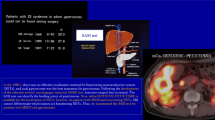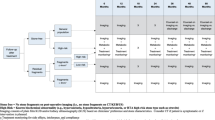Abstract.
Background: Gastro-duodenal polyps develop in up to 90% of familial adenomatous polyposis (FAP) patients and periampullary carcinoma is one of the most common extra-colonic malignancies in this syndrome. Periampullary adenomas have been shown to be precursor lesions to periampullary carcinoma. Sulindac, a non-steroidal anti-inflammatory drug, has been reported to cause regression of rectal polyps in FAP patients, however its role in periampullary polyp regression is unclear. Methods: In May 1993, a prospective study was begun to evaluate the role of sulindac in prevention of polyp recurrence after resection of large (>1 cm) duodenal polyps in FAP patients. Eight patients, mean age 50 years (range 35 to 65), with documented large periampullary polyps were placed on sulindac 150 mg twice daily. Prior to enrolment, all patients had their large polyps removed from the periampullary region by interventional endoscopy or by surgery. All patients had multiple small residual duodenal polyps. Follow-up was performed by one experienced endoscopist with a side-viewing video endoscope. Endoscopy was performed 6 monthly. Median follow-up time was 17.5 months (range 10 to 24 months). Results: In 3 patients, sulindac was discontinued due to side effects: abdominal cramps (n = 2) and upper G-I bleeding (n = 1). None of the patients had regression of small periampullary polyps. In addition, one patient developed an invasive periampullary carcinoma while on sulindac and 3 patients developed large recurrent periampullary polyps requiring further treatment. Summary: In our experience, sulindac is of no significant benefit for the control of periampullary polyps in FAP. Effective medical treatment of these polyps is still lacking.
Résumé.
Des polypes gastroduodénaux se développent dans près de 90% des sujets atteints de polypose adénomateuse familiale et les cancers péri-ampullaires constituent dans ce syndrome l'affection maligne extra-colique la plus fréquente. Les adénomes péri-ampullaires se sont révélés être des précurseurs des carcinomes péri-ampullaires. Des travaux ont montré que le sulindac, un anti-inflammatoire non stéroïdien, permet la régression des polypes rectaux en cas de polypose adénomateuse familiale. Toutefois le rôle de ce médicament dans la régression des polypes péri-ampullaires n'est pas précisé. Depuis mai 1993, une étude prospective a débuté afin d'évaluer le rôle du sulindac dans la prévention des récidives de polypes après résection de grands polypes duodénaux (plus d'un cm) chez des patients atteints de FAP. Huit patients dont l'âge moyen est de 50 ans (35 à 65) porteurs de larges polypes péri-ampullaires bien documentés, ont été soumis à un traitement de sulindac à raison de 150 mg deux fois par jour. Avant d'étre inclus dans l'étude, tous les patients out subi l'excision de larges polypes de la région péri-ampullaire par résection endoscopique ou par chirurgie. Tous les patients étaient porteurs de multiples petits polypes duodénaux résiduels. Le follow-up a été réalisé par un endoscopiste expérimenté avec un vidéo-endoscope à vue latérale. L'endoscopie a été réalisée tous les six mois. Le suivi moyen est de 17,5 mois (10 à 24 mois). Chez trois patients, l'administration de sudinlac a dûêtre interrompue en raison des effets secondaires deux fois, crampes abdominales (n = 2), et saignements de la partie supérieure du tube digestif (n = 1). Aucun de ces patients n'a présenté de régression des petits polypes péri-ampullaires. Chez un patient, on a assisté au développement d'un cancer péri-ampullaire invasif alors même qui'il était sous sulindac et trois patients ont développé de larges récidives de polypes nécessitant un traitement complémentaire. En conclusion, dans notre expérience, le sulindac n'a aucun effet bénéfique significatif dans le contrôle péri-ampullaire chez des patients porteurs de FAP. Un traitement médical effectif de ces polypes fait toujours défaut.
Similar content being viewed by others
Author information
Authors and Affiliations
Additional information
Accepted: 17 December 1996
Rights and permissions
About this article
Cite this article
Richard, C., Berk, T., Bapat, B. et al. Sulindac for periampullary polyps in FAP patients. Int J Colorect Dis 12, 14–18 (1997). https://doi.org/10.1007/s003840050071
Issue Date:
DOI: https://doi.org/10.1007/s003840050071




